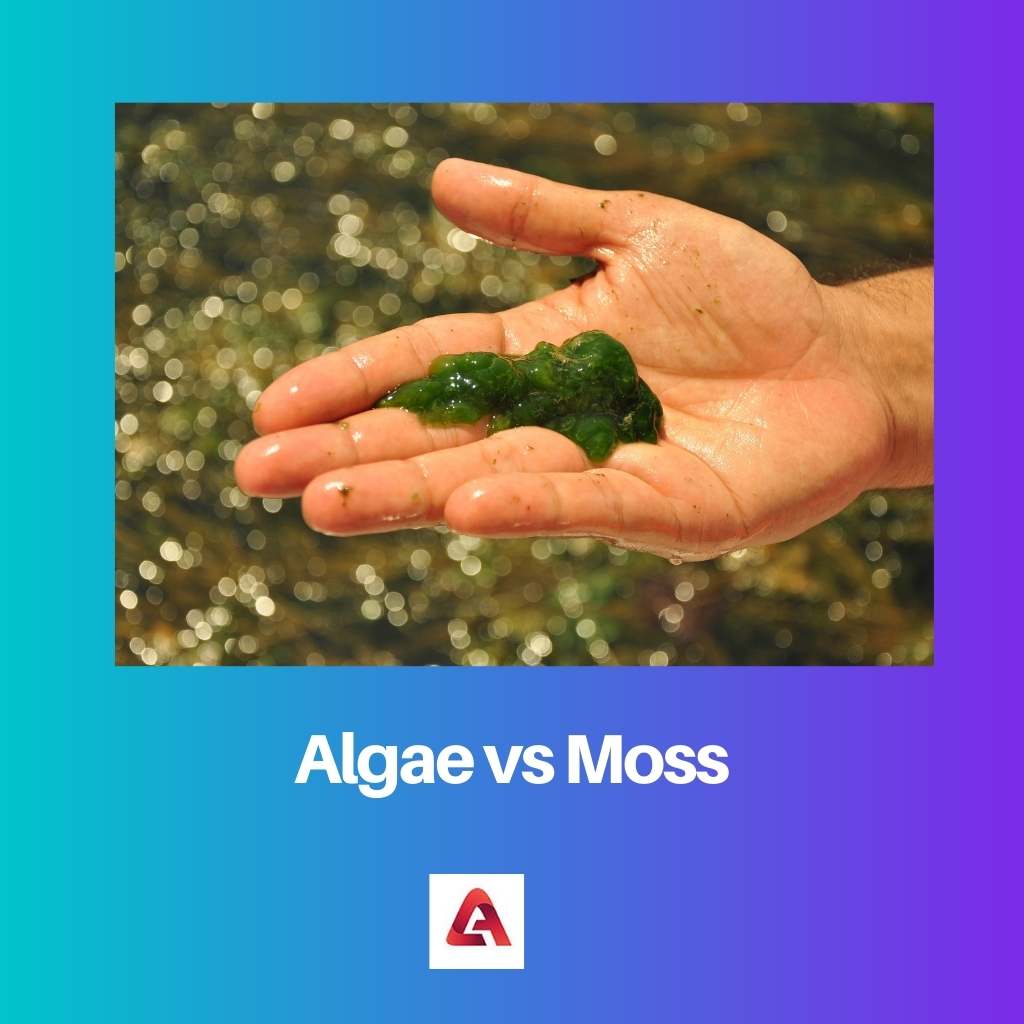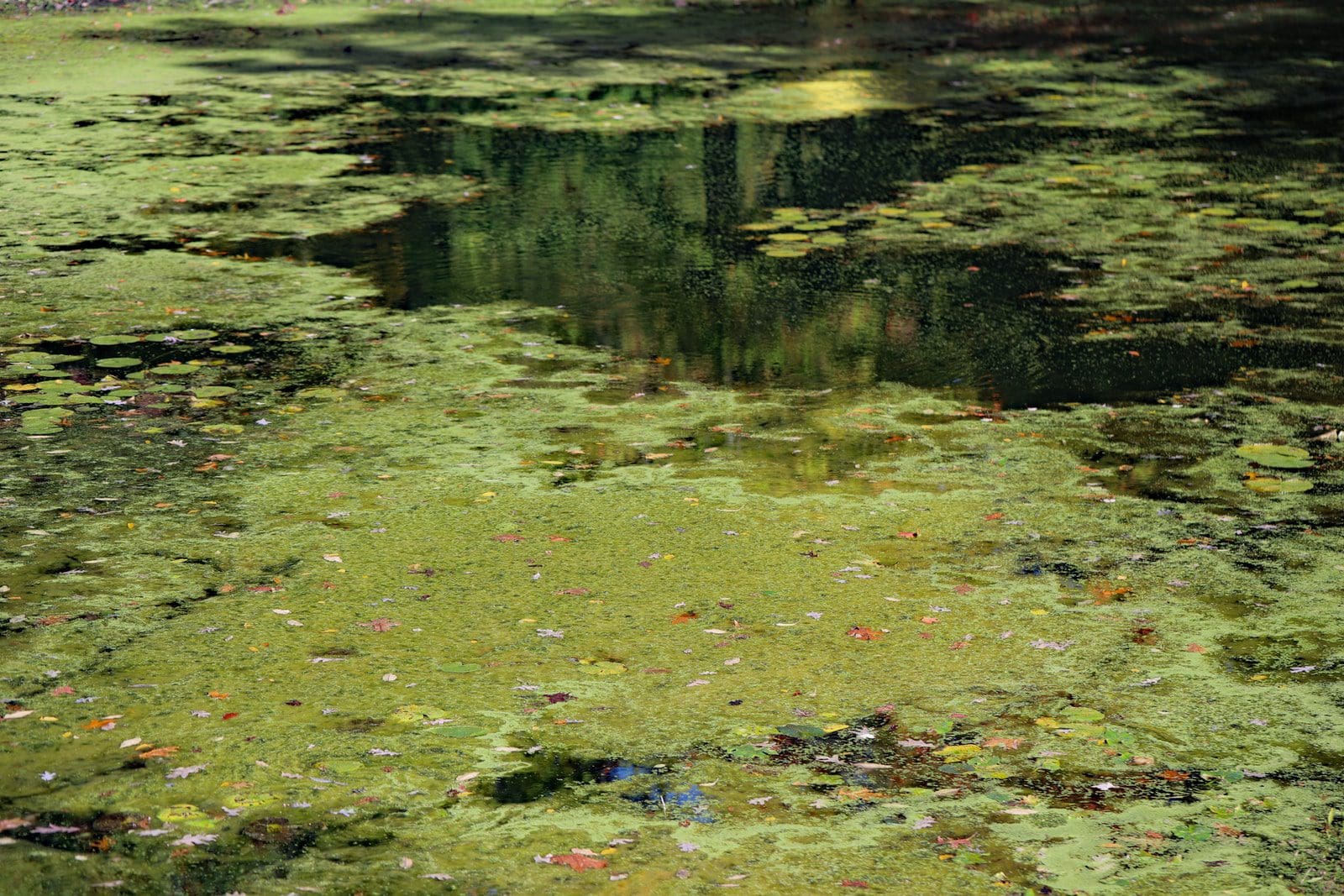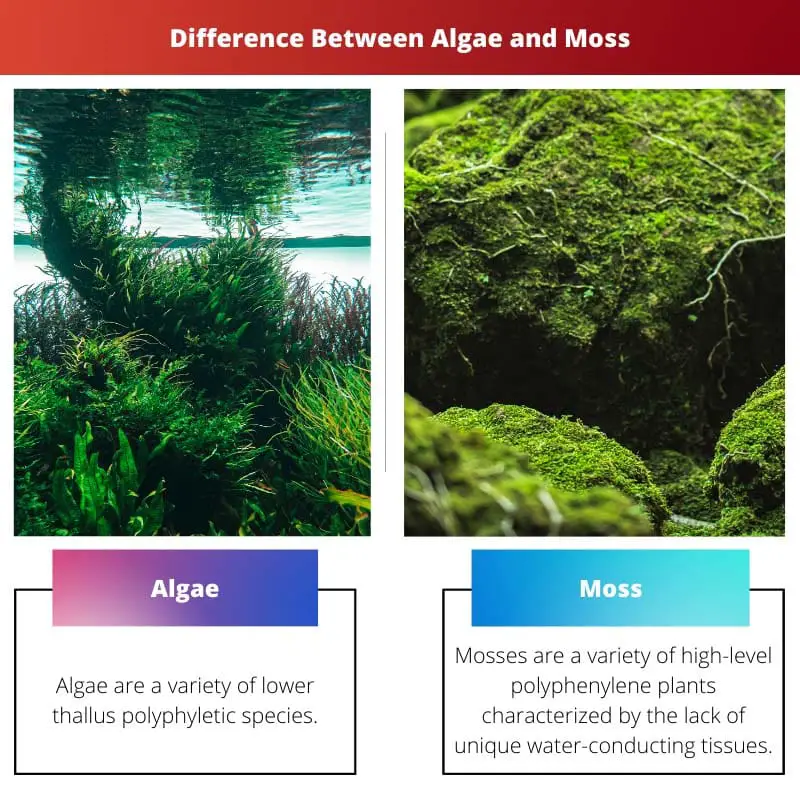Moss and algae appear similar from a distance: green plant life patches. Specific variants known as “moss,” such as Irish moss, are a variety of algae.
Algae and moose are two primitive plant species that produce non-vascular, non-flowering, and non-seed. They emerge in aquatic or wet surroundings.
Real moose and algae are separate species in certain parts of the United States; moss and algae concern lawn gardeners.
Key Takeaways
- Algae are photosynthetic aquatic organisms that range from unicellular to multicellular forms, whereas mosses are small, non-vascular plants that grow in moist environments.
- Algae reproduce through asexual or sexual reproduction, and some species can produce toxins harmful to humans and aquatic life, whereas mosses reproduce through spores and are not toxic.
- Algae play a crucial role in the aquatic food chain and ecosystem, whereas mosses help prevent soil erosion, retain moisture, and provide habitats for small animals.
Algae vs Moss
Algae are aquatic and can be single-celled or multicellular, while mosses are terrestrial plants without true roots, stems, or leaves. Algae produce oxygen through photosynthesis, while mosses do not. Algae are a variety of lower plants of the Protista Kingdom. Moose is a small flowerless plant of the Bryophyte division of the Plantae Kingdom.
Moreover, algae are thallophytes, and moose are root-like, shoot-like, and leafy.

Algae also produce and photosynthesize chlorophyll. Furthermore, algae function in most marine food chains as primary producers.
They also provide 70% of the oxygen in the atmosphere.
Moss is an early plant known as Bryophytes. They are non-Semitic, non-floral, and non-vascular.
Comparison Table
| Parameters of Comparison | Algae | Moss |
|---|---|---|
| Definition | Algae are a variety of lower thallus polyphyletic species. | Mosses are a variety of high-level polyphenylene plants lacking unique water-conducting tissues. |
| The Number of species | About 30000 algae exist. | About 12,000 varieties of mosses exist. |
| Science | Algology is called science, which studies algae. | Bryology is called science that studies moose. |
| Structure | The algae are single, multicellular, and colonial. | Multicellular species are all mosses. |
| Divisions | Diatoms of the algae are classified into green, red, and brown. | Hornworts, bryophytes, liverworts, and peat mosses are split between the moose. |
| Length | Mosses are a variety of high-level polyphenylene plants characterized by lacking unique water-conducting tissues. | About 1 cm and 10-20 cm. |
What is Algae?
The word “algae” applies to several species that produce photosynthesis oxygen (harvesting light energy from the sun to generate carbohydrates).
Both species do not have a parallel connection. However, some characteristics combine with the main photosynthetic species, the soil plants, that distinguish them from each other.
Algae are not mainly strongly distinguished since they lack genuine roots, stems and leaves, and avascular structure for water flow and nutrients through their bodies.
Secondly, many algae appear in several shapes and sizes as well. They can occur as single, multicellular, macroscopic, live in colonies, or be leafy like it does with ocean floors like giant kelp.
It can be a microscopic cell. The picoplankton has a diameter from 0.2 to 2 microns, and the fronds of giant kelp are as long as 60 m. Finally, algae are present in freshwater and saltwater in various marine environments.
Because of this, prokaryotic organisms—cyanobacteria, also called blue-green algae—and eukaryotic organisms are the common name “algae” (all other algal species).
“Because the ‘algae’ does not form part of the natural community from a shared ancestor, and the name ‘eukaryotic algae’ does not include the cyanobacterial bacteria into an informal group “algae.” Interestingly, chloroplasts are modified amino systems and the site of photosynthesis in land plants. Often during late Proterozoic or early Cambrian times, these early cyanobacteria are enclosed in primitive plant cells.
(Bacteria and archaea are included in prokaryotes. They are more superficial species without an ordered cell structure, and their DNA floats loosely in the cytoplasm as a twisted mass.
To the other, all other living species are eukaryotes: fungi, protists, and plants. And birds, and what are protists? They organize their cells better.
They have organelles complexes that perform various cellular functions, and DNA is contained in a central compartment called the core.)

What is Moss?
Moss (Bryophyte Division) is a minute, non-vascular, spore-bearing plant of at least 12,000 species. Mosses are present in humid, shady sites worldwide and in salty water.
The animals that tapestry woods and the forest floors are best known. Eco-friendly, exposed substrates break down and release nutrients for more complex plants.
It is essential in the nutrient and water economy of certain forms of vegetation and helps manage soil erosion with the surface cover and absorption of water.
Those in the Sphagnum genus that shape turkey are economically significant animals.
Mosses were already found during the Permian Period (298.9 million to 252.2 million years ago), and there were over 100 organisms known in the Paleogenic and Neotenic fossils (66 million to 2.6 million years ago).
In a structure comparable to modern genera are Miscites and another fossil Moses. Valvate and peat mosses are the extent of species included (subclass).
The large subclass is the majority of mosses, but there were also significant representatives of Polytrichids. Also, only a few animals have smaller subclasses.
The arrangement and specialization of their sporangia are mainly different from each other (spore cases). Mosque plants form a gametophytic (sex) generation in stem and leaflike structures.
The generation from the gametophyte grows sporophyte (Asexual) and is normally a higher stem or seta, which ends in the sporangium. The sporangium also varies depending on the gametophyte for water and nutrients.
Mosses replicate by branching and fragmenting, regeneration, and development of spores from small parts of leaves or stem. The spore germinates and becomes a branching green thread in favourable conditions.
Typically, numerous small plants that bear the name moose are not Moses. The green alga Pneumococcus is always the “moss” found on the Northside of the forest.
Irish mouse is a red alga (crepe). Beard, Iceland, oak, and reindeer moss are lichens. The lichens of the beard mousses (species).
The Spanish moose is an aeroplane of the pineapple family (Tillandsia) (Bromeliaceous). Fern allies of the Lycopod family are club moose.

Main Differences Between Algae and Moss
- Algae are primarily freshwater and aquatic organisms. Certain plants have been adapted for living in damp soils, bark forests, wet rocks, etc. Whereas most moose are aquatic, certain species have been modified to survive in water.
- Algae may be floated or connected by special cells to the floor of the water basins or other substrates. In contrast, moss is found on dirt, rock, tree, and other surfaces that can be fitted with the substratum.
- Some algae are used in the food and pharmaceutical industries. At the same time, moss peat is used for fertilizing and growing plants, heating, and the treatment of rheumatoid diseases.
- Algae types Ulva, Spirogyra, Coralline; Sargasso, Ectocarpus, Meliora, etc. Moss types Megaceros, Byrum, Lunular, Sphagnum, etc.
- About 30000 algae exist. In comparison, about 12,000 varieties of mosses exist.


I never knew that algae produce 70% of the oxygen in the atmosphere. This is mind-blowing!
It’s fascinating, isn’t it? Algae are crucial for our planet’s ecosystem.
Absolutely, this article provides a great understanding of the significance of algae.
The details provided in this post are impressive. I appreciate the comprehensive analysis of algae and moss.
I’m glad to have come across this article. The comparison between algae and moss is detailed and well-explained.
I couldn’t agree more. The information here is valuable and well-presented.
Very informative! I’ve learned a lot about the differences between algae and moss.
Yes, this was a very enlightening article. I appreciate the detailed comparisons.
This article is a great resource for understanding the significance of algae and moss in the natural environment.
Absolutely, the ecological importance of both algae and moss is clearly explained here.
I couldn’t agree more. The comparison table was very helpful in understanding the differences.
I’ve always been interested in botany, and this article has expanded my knowledge significantly. Well done!
I completely agree. The comparison between algae and moss is thoroughly explained.
The insights provided in this article are remarkable. It’s a great read for anyone interested in plant sciences.
I’m glad to have read this post. It’s very enriching and educational.
This post is an excellent resource for anyone interested in plant biology. I appreciate the scientific depth of the content.
I couldn’t agree more. This article offers a comprehensive understanding of algae and moss.
Absolutely, the scientific explanations are highly informative and well-articulated.
The in-depth analysis of algae and moss in this post is incredibly valuable. Thank you for sharing this information.
I’m so impressed by the level of detail in this article. It’s truly enlightening.
The detailed comparisons and explanations in this article are truly impressive. I highly recommend it to plant enthusiasts.
I couldn’t agree more. This article provides valuable insights into the world of algae and moss.
Absolutely, the depth of knowledge shared here is commendable.